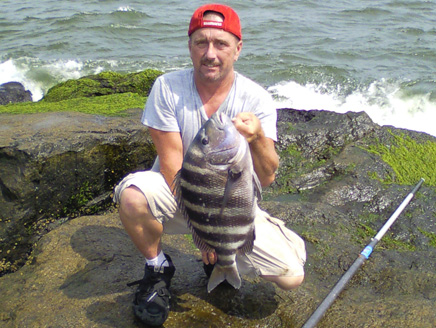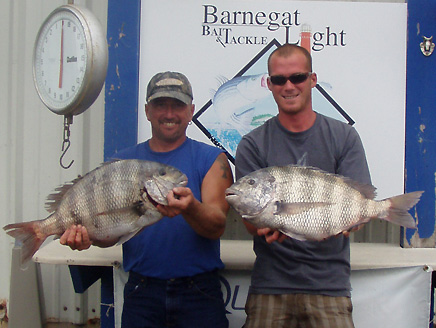

Sheepshead Here in the Northeast are Wanderers...and the More Food they Find...the BIGGER They are Going to Be!
Story and Photos by Bob Misak
What's a Sheepshead?
Here in the Northeast, where the weather changes from season to season like the colors of a chameleon, there has been a change in the making. Warmer water temperatures have brought about some new species of fighting fish, and the sheepshead is slowly joining the group of “northeast nomads”. Sheepsheads look very much like a black drum, with a few distinguishing features that separate the two. Large protruding teeth are the main way to identify the sheepshead from a drum, as drums are toothless. The long pointed side fins are another feature that separate it from the similarly colored drum, as both species are a gray or silvery color with well defined, vertical black stripes along the entire body. I have seen folks toss a sheepshead back into the sea, thinking they were small black drums. This could very well be the reason that few large sheepsheads see the hooks of a scale. However, as time goes on and more fish are caught, sharp anglers are getting wise to the existence of the sheepshead in New Jersey waters.
The sheepshead is a staple of the fishing community in the south, and is often targeted and eaten in states like Florida and Louisiana. The sheepshead is in fact, a great eating fish. I find that most fish that are crustacean feeders are usually quite tasty. The food a fish eats most certainly reflects the taste of the meat, and sheepsheads, triggerfish and togs are some of the crab eating species that are consistently targeted by the “connoisseurs of the fry pan”. But here in the northeast the sheepshead has usually been caught by accident, by jetty jumpers and bridge huggers alike. But with the sheepshead numbers growing rapidly, they are consistently being targeted by some of the craftier anglers out there. In fact, Delaware’s state record was broken not long ago and now New Jersey’s record has been broken at a mind-boggling 19 pounds. This is far larger than Florida’s record at 15 pounds and change, where the sheepshead makes it home. However, the world record sits at 21 pounds plus, caught on the coast of Louisiana. Landing a trophy sheepshead will put you among the elite group that have crossed the fish off of their “trophy bucket list”, and with the northeast species being mostly large and in charge, a world record in New Jersey or New York is by no means out of the question. |
| This 11 lb. sheepshead was taken off of the Barnegat Inlet south jetty in late September by Bob Misak. Northeast sheepshead are larger than their smaller Southern relatives. |
How Big?
The sheepsheads that are caught regularly down south are an established “bucket” fish, meaning that most seasoned southern anglers will toss them into the box for a solid meal of white meat, and are on the average about three to five pounds each. A lot of smaller fish are taken, and eating them is commonplace in Florida, Louisiana and Georgia. This could be the reason that sheepsheads caught south of here are typically smaller. Comparatively, the fish caught here in the north are bruisers. I have caught a fair amount of sheepsheads off of the jetties at the New Jersey coast, and the areas from Barnegat Light to Cape May have been a virtual hot bed for big fish in the past six or seven summers. The six fish I have had the privilege of catching have all broken the ten pound mark and I have heard of only a few that were under that size. This is understandable, since the sheepshead state record in New Jersey that stands (or formerly stood at 17 pounds, 3 ounces, was caught by Paul Lowe of Manahawkin, N.J., under the Causeway Bridge in Manahawkin. The world record however, was caught off of the southern coast of Louisiana by Wayne Desselle of New Orleans back in 1982, and still stands at 21 pounds, 4 ounces. The warm waters down in the Gulf are the sheepsheads original stomping grounds. But oddly, the state record in New Jersey is actually bigger than the Florida record. That sheepshead, at 15.25 pounds, was taken in Laguna Madre on a live shrimp in 2002 by Wayne Gilstrap. Oddly, New York does not have a current state record for sheepshead that I could find, making it “anyone’s game”, and Delaware’s record is pretty impressive at 13 pounds, 11 ounces landed in 2000.
The fish we are seeing up here in the northeast are wanderers, and the more food they find, the bigger they are going to be, as a rule, which sort of explains the record up here in New Jersey being larger than the record in the fishes’ regular stomping grounds. The northeast provides a virtual smorgasbord for these fish, with green crabs and other species of crustaceans in full natural supply. Will they set up shop here? With food availability and water temperatures rising like never before, the sheepshead may very well be here to stay, in the comfortable, structure and crab-packed waters of the northeast. |
| The author and his son hold two "twin" 13 lb. 5 oz. Sheepsheads. The pair were caught on Long beach Island, N.J. |
Catching the Elusive Sheepshead...
If one has an interest in catching sheepsheads up here in the northeast, the first thing you should have is a good dose of patience, and an equal dose of persistence. The eight sheepsheads that my son and I have managed to land since 2005 were caught on adrenaline and opportunity. We continually fish jetties for tautog, our favorite eating fish. Of the forty to fifty trips we take for togs on the rocks each summer, we may take one or two sheepsheads. We have also lost another four or five fish on the sharp structure, or because we were simply off of our game on that day. In my opinion, shore crabs are the bait of choice. I believe that they are the natural bait to the sheepshead (up here in the northeast), so we try to “match the hatch” in all of our fishing endeavors, with sheepshead being no different. We once caught two sheepsheads in one day out on the rocks, and lost another, proving that the fish travel in schools. However, those schools seem to be small...with three or four fish traveling in unison. That is why when we do hook and land a “sheep” (as we like to call them), we are quick to re-bait and get that line back down, hoping to hook another right away. But one thing seems to always remain the same. The fish are all equally sized, with two fish we landed being exactly 13 pounds, 5 ounces each...caught on the same day off of the same rock on Barnegat light’s South Jetty in 2008.
Today, sheepsheads are broadening their range. Several bruiser fish were taken down off of Avalon Bridge in Avalon, and some were caught off the Ocean City and Brigantine Bridges as well. The current unofficial 19 pound state record was reportedly caught in Little Egg Inlet where many sheepshead saw their demise in recent years. Some fish are starting to be caught off of New York, and not a day too soon at that. It won’t be long before sheepsheads are a regular catch for the anglers of New York, and the state record will be broken a few times before a big bruiser sets it in stone. Boaters are now on the wagon train as well. They will anchor or drift under bridges and toss crab baits onto the abutments; this is how a lot of big fish got a ride on the scales this year, and this is how the current “new” New Jersey state record was nabbed. The sheepshead is here to stay, and as long as food and habitat is here, they are only bound to increase in number and become one of the “elite trophies” that hard core anglers will target in years to come.
When and How...
When trying to target and catch sheepshead, one wants to think summer, since the fish love warm water. August and the first two weeks of September have typically been when we here in New Jersey “shoot for sheepsheads”. Depending on the weather patterns for that particular year, you can actually catch fish in July and through September...and sometimes into October. But again, this is during a year when things warm up quickly and stay warmer longer into the season. I prefer to start in mid-July and go through September, optimizing my chances by simply being where the sheepshead may “graze”...which means as many of the summer days as is possible. Your gear can be light, and I have landed sheepshead on light tackle, but it should be good equipment. I find 50 pound braid is comfortable for me. I rarely size down, since structure is unforgiving and losing a fish on a sharp rock is certainly an issue. Rods can be short, as short as seven feet, but should be stout. I like a heavy action rod with some sensitivity, like a St Croix Avid or a G-Loomis GL-series. Since I use only Shimano reels, a Stradic 4000 is my choice reel, as it has a fool-proof drag system and will give you less chance of “technical difficulties”.
Rigs don’t have to be anything that hasn’t been used before. I catch most of my sheepshead on a dropper loop with light sinkers (some as light as one ounce), fishing in 30 feet or more of current laden waters. Feeling for bottom and making sure that you are down deep is essential. If necessary, up your weight because of the thickness of your line, it’s best to do so. The leaders are fifty pound flouro-carbon at the very least. Going bigger, perhaps sixty pound test will ensure a solid hook-up, and give you some more confidence that you won’t be standing there with a frayed leader and a lost fish. To put it simply, the same rigs used for blackfish can be effective for catching sheepsheads, though my first fish, a bruiser at just over 15 pounds, (and an unofficial state record at the time) actually took a jig and Finesse bait intended for weakfish. Mostly though, we will go and catch a bucket of Asian crabs and use the largest of the bunch, which typically are about the size of a quarter or as big as a half dollar.
The tide should be running out, and we never fish the “dirty water low”, which is when the tide gets so low that silt from the bottom begins to cloud the water. This cuts your chances in half as sheepsheads, like many other fish rely on sight as well as smell. When you get a hook into a big sheepshead on the structure, you will know it. They don’t head for a rocky lair like a tog, and they’re certainly far more squirrelly than a triggerfish. They will use the current to their advantage. Their thick, powerful bodies will run back and forth in the currents, and once you see that you have a sheepshead on, you can only hope that it doesn’t see you first, or the fight is on again!
The sheepshead is like a bluefish. it doesn’t tire, and it doesn’t run out of fight. You will have your hands full right up until the moment that you get it into the net. So now that the sheepshead numbers are actually big enough to target them as a trophy fish, go out and give it a try! Find a bridge or jetty, and be persistent. Hold on to that rod, and lastly, make sure that your drag is set just right. You may just be the new state record holder in your stomping grounds! Good luck and great fishing for the “new trophy” of the northeast, the elusive and powerful sheepshead.














